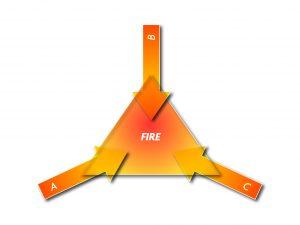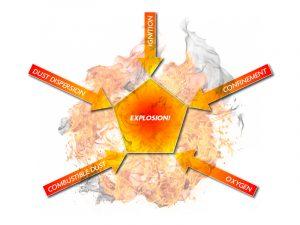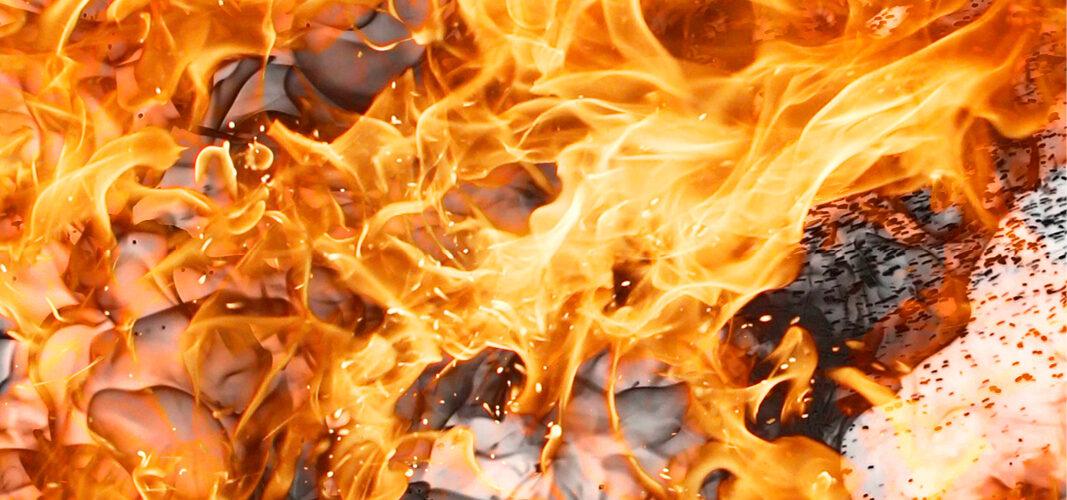When we are dealing with a fine powdered material or product in a gas phase, some precautions are required in order to ensure safe processing and handling. The smaller the particles, the lighter will a powder-air mixture become. The bulk material’s density will be of less importance below a certain size limit as the particles’ own mass relative to the surrounding gas will equalize and the mixture classifies an aerosol (≤1 micron). Daily we all experience dust in our homes. And as experienced, the larger particles tend to reside on the floor while the fine dust goes just about everywhere.

Generally, if we have a compound or material with low ignitability in its bulky shape it can be made to burn, even violently, by diminution into small enough particles. This holds as long the material contains some combustible component(s). In the case of a combustible material in small enough parts we fill two corners of the fire triangle (A, oxygen and B, fuel). Add a spark (C, ignition) and the triangle is complete meaning fire! We know this well from making camp fires or heating our saunas with logged wood.
Generally, when dealing with powder materials as fine dust in air five parameters are used and the triangle expands with another two corners. If we have combustible dust (dispersed particles) in a confined space (pressure) subjected to an elevated temperature (ignition) the so-called dust explosion pentagon is fulfilled. The result will be a violent fire propagation/explosion that might result in significant surrounding construction material devastation. History can tell several such cases of varying severity. In case of dust containing some highly evaporative substance or component only four fulfilled criteria can be enough to cause ignition and an explosive fire.
The Dust Explosion Pentagon

Looking closer into the dust explosion pentagon key factors, we find dust particle size distribution, degree of particle de-agglomeration, particle concentration distribution and turbulence of the cloud to be the critical elements. Moreover, the physical and chemical properties of the dust, the type, energy, and location of the ignition source together with the container geometry and temperature, pressure and humidity of the dust/air mixture are important factors. In case of a dust material classifying low-risk this does not equal no-risk conditions at any case in the chain of handling.
The standardized (ISO 6184-1, ASTM E1226) combustibility index (CI: 1-5) classifies the fire propagation kinetics in a dust cloud of particles by their maximum explosion pressure, rate of pressure increase and an explosion index providing numerical values for comparison. Here a higher index implies a more fire-sensitive dust. Dry modified starch products themselves do not classify high on this list. However, as dust explosion criteria are being filled also this natural polymer becomes a dangerous mixture that may cause an explosive fire. By avoiding any nearby sources with elevated temperatures (<400°C), igniting sparks or naked flames in any product handling step such situations are avoided. The product material safety data sheet describes these safe handling precautions.
The minimum ignition energy (MIE) for dry modified starch products is high, of order: 1000 mJ. The MIE number is a measure of dust cloud explosion sensitivity to electrical spark ignition. A high value implies that much external heat energy is required to ignite the mixture. This number provides guidance for plant personnel and logistics. In comparison to other compounds and products starch is rather insensitive towards spark ignition:
| Compound | MIE, mJ |
| Aluminium dust | 100-300 |
| Coal dust | >1000 |
| Flour | 300-1000 |
| Modified starches (dry) | 1000 |
| Sewage sludge | 30-100 |
| Sugar | 10-30 |
All Chemigate production sites are conformant with EU’s ATEX directive (potentially explosive atmospheres, Directive 2014/34/EU). We have tested our own products for sensitivity to dust explosions. The test reports have indicated that even when finely ground (D50=29 µm) the modified starch products display low or very low combustibility at room temperature. To achieve explosive conditions significantly elevated temperature are required, as the self-ignition occurs above 400°C. Although these figures indicate low risk for dust explosion, despite operating a risk-assessed handling step, this cannot 100% eliminate the chance of something unexpected to occur. Processes operating at minimized risk conditions is today standard procedure in the majority of paper industry sites. Safe handling of the dry-modified starch products in accordance with their MSDS and TDS implies not subjecting the powder materials to 1) elevated temperatures, 2) naked flames or 3) electrically induced sparks when handled in ATEX-approved facilities.
– Tom Lundin D.Sc. (Tech.) Senior Expert (Sales and R&D)
References:
- Pinnick, R.G. et al. (1983) https://www.ncbi.nlm.nih.gov/pubmed/18195752
- Eckhoff, R.K. (2009) http://www.sciencedirect.com/science/article/pii/S0950423008000727
- “HvacMan” http://www.iklimnet.com/expert_hvac/dust_explosion_factors.html
- osha.com https://www.osha.gov/OshDoc/data_General_Facts/OSHAcombustibledust.pdf
- iso.org https://www.iso.org/obp/ui#iso:std:iso:6184:-1:ed-1:v1:en
- astm.org https://www.astm.org/Standards/E1226.htm
- ATEX Directive 2014/34/EU http://ec.europa.eu/growth/sectors/mechanical-engineering/atex_en
- EHTL 2004 http://explosiontesting.co.uk/mie_15.html

